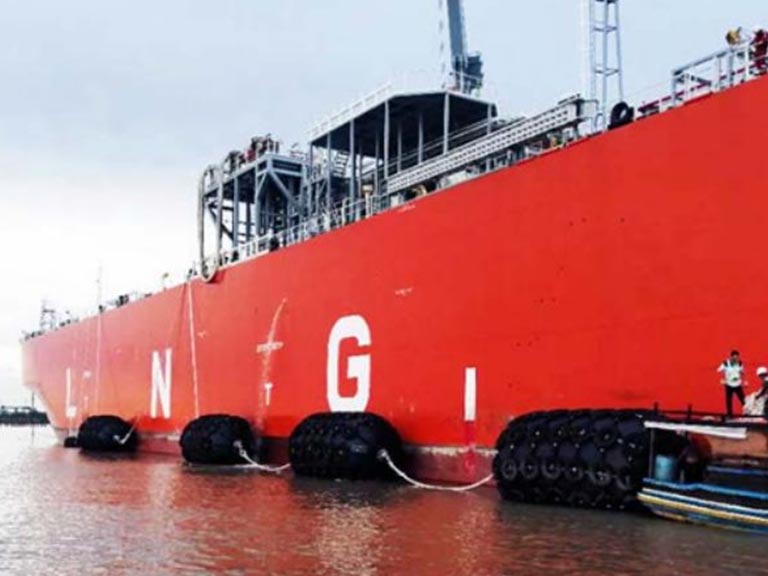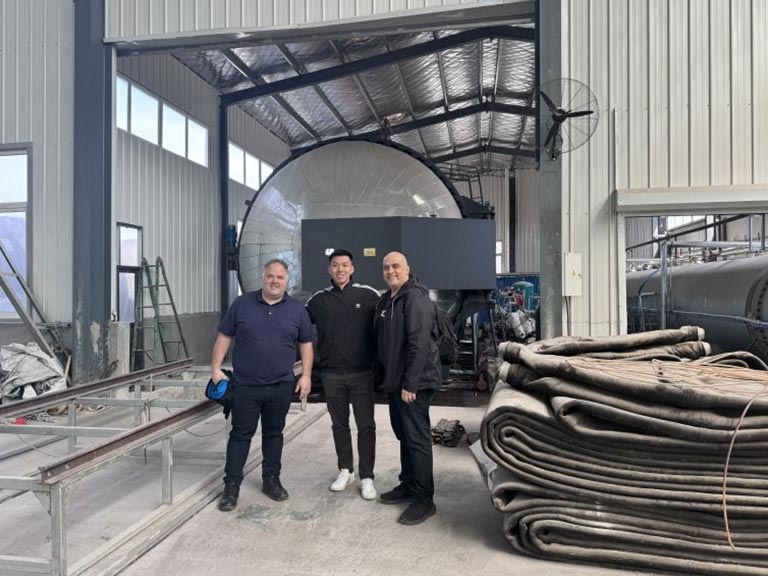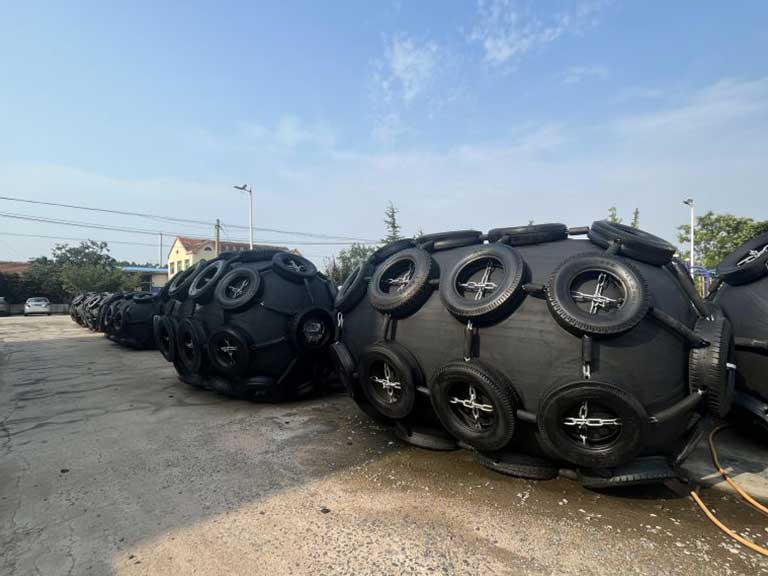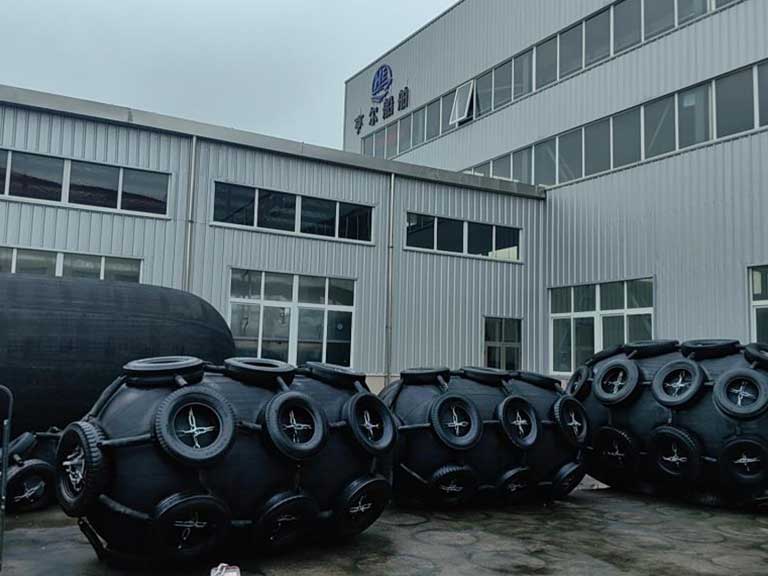Pneumatic Rubber Fenders are an important piece of equipment widely used in the maritime industry to protect ships, wharves, and other port facilities from damage during berthing or mooring. Its flexibility and efficient energy-absorbing properties make it widely used in all types of vessels and offshore installations.
Severe weather poses major challenges to ships and port facilities, such as high wind speeds, strong waves, extreme temperatures, sea ice and floating debris. These factors not only affect the operational safety of ships, but can also cause serious damage to hulls and port facilities. Under such circumstances, the reliability and durability of inflatable fenders, as important buffer protection equipment, is particularly critical.
Table of Contents
The impact of bad weather and the environment on marine operations
Safety in marine operations is closely related to high adverse weather and environmental conditions, including wind speed and waves, extreme temperatures, and sea ice and floating objects.
Wind speed and strong waves: High wind speed and strong waves are common bad weather phenomena, which will greatly impact the ship’s berthing and berthing operations. Strong waves not only affect the vessel’s stability but also cause severe wear and tear to the terminal facilities.
Extreme temperatures: Extreme high and low temperatures pose a serious challenge to the durability of marine equipment materials. Inflatable fenders may suffer from material deterioration and performance degradation under extreme temperatures, affecting their cushioning and protective effect.
Sea Ice and Floating Objects: In cold waters, sea ice and floating objects pose a particularly significant threat to ships and fender systems. Collisions with ice and floating objects can cause damage to the hull of the vessel and even jeopardize the safety of the crew.

Inflatable Fender design and material selection
Henger Marine’s high-quality fenders, which have been proven time and time again in marine applications and are very popular in the Middle East and Southeast Asia, are made possible by the unique design of Henger Marine’s inflatable rubber fenders and the selection of high-quality raw materials to cope with and minimize the effects of harsh environments on the use life of inflatable fenders.
Henger Marine’s inflatable rubber fenders are typically made of weather-resistant rubber and polymer materials that maintain excellent elasticity and strength in extreme weather conditions. These materials are highly tear, UV-resistant, and resistant to chemical corrosion and aging.
Multi-layer structure design and good airtightness are important guarantees for the durability of inflatable fenders. The multi-layer structure effectively disperses the impact force and reduces the single-point force, thus prolonging the service life.
For high and low-temperature conditions, inflatable fenders can be designed with the ability to automatically adjust pressure to maintain optimal performance at different temperatures. Material selection and formulation adjustments can also enhance the fender’s adaptability in extreme temperatures. To learn more about pneumatic Fender pressure, check out the Inflatable Fender Pressure page for more insights.

Performance in the face of high wind speed and strong waves
Because of Henger Marine’s unique fender structure design and the use of high-quality raw materials. Henger Marine’s inflatable fenders can effectively absorb impacts when facing high wind speeds and strong waves, reducing the risk of damage by minimizing the direct contact between the ship and the pier.
When dealing with high wind speed and strong waves, the inflatable rubber fender is equipped with auxiliary fixing systems such as chains and tire nets to prevent its displacement and ensure its stability and effectiveness in bad weather.

Adaptability to extreme temperatures
Henger Marine’s inflatable rubber fenders are made from rubber materials that can withstand both extremely high and low temperatures, ensuring that they remain resilient and strong enough to perform their protective function in harsh environments.
Moreover, the use of highly weather-resistant rubber and the addition of special additives in the production of Henger Marine can enhance the performance of the fenders under extreme temperatures. These materials not only resist embrittlement caused by temperature changes, but also maintain good physical properties.

Meeting the challenges of sea ice and floating debris
When dealing with sea ice, Henger marine inflatable rubber fenders have excellent impact resistance. When sea ice or floating objects come into contact with the ship, the fenders are able to absorb the impact through their elasticity and flexibility, minimizing damage to the ship’s hull and facilities.
In extremely cold environments, the Henger team has taken into account the brittleness resistance of the rubber material in its design, which is able to maintain its flexibility at low temperatures, thus effectively protecting ships and harbor facilities.
Comparing Pneumatic Fenders with Alternative Solutions
Comparing pneumatic fenders to alternative solutions reveals their unique strengths in handling adverse weather conditions. We will analyze the comparison between pneumatic fenders and other types of fenders. In particular, we will compare their performance, durability, and maintenance with foam-filled fenders.
Pneumatic vs. Foam-Filled Fenders in Harsh Conditions: Pneumatic rubber fenders and foam-filled fenders differ significantly in structure and performance. Pneumatic fenders have air-filled chambers, allowing them to absorb impact energy effectively. In contrast, foam-filled fenders have foam cores and polyurethane layers. This makes them less prone to air loss when damaged but also less effective at absorbing energy after damage.
Durability and Maintenance Considerations: In terms of durability and maintenance, pneumatic fenders require annual air pressure checks. Foam-filled fenders need only visual inspections. However, foam-filled fenders are generally more expensive, costing up to three times as much as pneumatic ones. We will help you weigh these factors to choose the most suitable fender for your operational needs.

Practical application cases
Case Studies
The use of inflatable rubber fenders in cold ports in areas where extreme weather conditions are common, such as in Northern Europe and Canada, has had significant results. The introduction of inflatable rubber fenders has dramatically reduced damage to ships due to collisions with wind, waves and sea ice.
Customer Feedback
Many users feedback that the performance of inflatable fenders is stable and reliable in bad weather conditions, which can effectively reduce the frequency of maintenance of ships and port facilities and lower operating costs, and is highly evaluated by customers during their later factory inspections and visits to the factory.
Conclusion
With their exceptional performance in various environmental challenges, pneumatic rubber fenders are an optimal choice for maritime operations. Henger Shipping Supplies has proven that our high-quality inflatable rubber fenders are durable and perform exceptionally well. They reduce the risk of damage to ships during port entry. In addition, they are safe in bad weather and good for the environment.
Pneumatic rubber fenders offer a robust defense against the challenges posed by extreme weather in marine environments. Their unique design features and material properties work together to ensure consistent performance. By investing in high-quality pneumatic fenders from us, maritime operators can reduce maintenance costs and enhance operational safety.

FAQs
How do inflatable fenders remain effective in storms?
Through the design of high-strength materials and multi-layer structure, the inflatable fenders can absorb most of the impacts, while the non-slip fixing system ensures that they do not shift in high winds and waves.
Do extreme temperatures affect the performance of inflatable fenders?
Inflatable fenders are made of weather-resistant materials that can maintain their performance in extremely high and low temperatures without becoming brittle or failing due to temperature changes.
How do inflatable fenders perform in the face of sea ice?
Its excellent elasticity and impact resistance enable the inflatable fender to effectively respond to the impact of sea ice and protect the hull of the ship and harbor facilities from damage.
What are the key benefits of using pneumatic fenders in marine operations?
Pneumatic fenders offer excellent shock absorption and are extremely durable. They can withstand harsh weather conditions and are the ideal choice for protecting ships and structures during mooring and berthing operations.
How do I manage the pressure in pneumatic fenders during varying weather conditions?
Proper pressure management is crucial. We recommend regular inspection and adjustment to ensure that the fenders maintain optimal pressure. This helps to ensure the performance and service life of pneumatic rubber fenders.
What are the maintenance requirements for pneumatic fenders?
You need to regularly check the pneumatic fender for damage and ensure that the air pressure is normal. In addition, you should ensure that the surface of the fender is clean and free of debris. This is a necessary maintenance task to extend the service life of the pneumatic fender.




